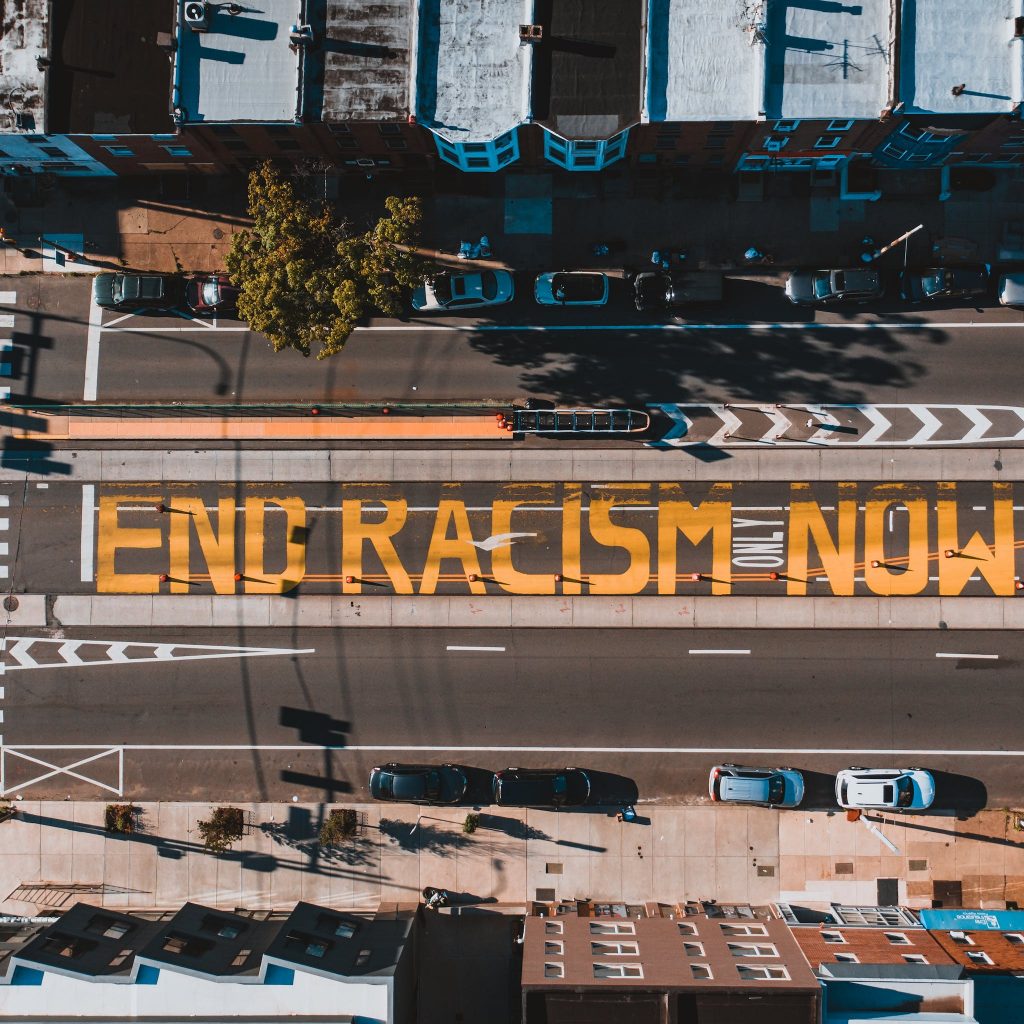Part of the Communion in Times of Coronavirus series of gentle reflections
Inderjit Bhogal, 2020
This article can be downloaded for use here
All documents on this topic are located here
Breaking Stereotypes: Questioning Colour Associations in Faith

I challenge the traditional notions that white is the colour of purity, and black is the colour of profanity; that white is the ideal colour, and black is bleakness; that white is good, and black is bad; that white represents law, and black represents criminality.
The association of white with good and clean and privilege, and black with bad and dirty and subjugation is deep set in so many ways.
All faiths have to engage with this theme. Does religion associate white with purity, and black with profanity? I am raising this question to provoke.
It is essential that theology, in all faiths, and in interfaith dialogue, addresses the colour-based discrimination, especially the association of blackness or darkness with badness, and whiteness with holiness. This will contribute to health and healthy and healing relationships. Black Lives Matter includes the challenge that theology cannot remain silent while black and dark-skinned people suffer the denial of their humanity and life.
Theology has to address the association of whiteness with purity and power, and blackness with profanity and powerlessness.
What is termed “racism” is the exercise of prejudice plus power. We all have our prejudices. But the way the world is ordered concentrates power in white and lighter skinned people. Black people live in a world in which blackness is identified with criminality.
Reinterpreting Biblical Narratives Of Colour
Christians have traditionally upheld white as the colour of holiness, and black as the colour of sin. Holy things, such as sacraments and scriptures are held and wrapped in white cloths.
However, it is not as straightforward, or as black and white as that. There are complexities and contradictions when attempting to challenge the conventional interpretation of white as holiness.
Faith based practice does not always reflect scriptural witness.
Let me illustrate by considering words that should be familiar to readers of the Bible.
Isaiah 1:18 where we read, “though your sins be as scarlet, they shall be as white as snow; though they be red like crimson, they shall be as wool” (KJV).
These words are traditionally taken to mean, though your sins are dirty they will be made clean, as white as snow.
I want to offer an interpretation that turns these words on their head.
It is illuminating always to consider the context in which scriptural words are said or written.
Biblical scholarship is broadly agreed that the Book of Isaiah can be divided into three sections.
In section one (Chapters 1-39), there is a warning and prophecy about exile; section two (Chapters 40-54) reflects the time in exile and promises a return from exile; section three (55-66) follows exile.
In section one then there is a focus on things getting worse because people have again turned away from God. They will be taken into exile.
Things are going to get worse.
In this context the words of Isaiah 1:18, though your sins are as scarlet, they will become white as snow may be taken to mean, you are going to go from scarlet to white. Things are going to get worse.
White as snow does not mean better and good and clean, it means quite the opposite. Let me illustrate this briefly.
Let us look at the use of the term “white as snow” in the Bible, by examining the first appearance of this phrase in some English translations of Numbers 12 where we read in verse 10 that “Miriam had become leprous, as white as snow”. What led to this?
What does the phrase “white as snow” mean here? Does the original Hebrew text even use the term “as snow”? My understanding is that it just refers to “white”.
Whatever the gloss, clearly it is pointing to something bad rather than something good, it is referring to impurity rather than purity.
Let us take a closer look.
The context is criticism of the leadership of the great Moses.
To criticise him Aaron and Miriam pick on the choice of his wife.
Moses had two wives.
A Midianite, who is not mentioned at all by Miriam and Aaron.
But his second wife is mentioned.
All we know about her is that she is a Cushite.
We know nothing else about her.
Cush is the southern-most territory mentioned in the Bible.
Cush is the ancient designation of territory on the Upper Nile, south of Egypt.
It can be reasonably assumed that the Cushite woman is of black African appearance.
Aaron and Miriam object to Moses being married to a black woman, and see this as the greatest weakness of Moses’ leadership to exploit.
What results from this colour-based prejudice in the community?
It leads to God actually making an appearance.
God “heard” the racist slurs (verse 2), and challenges it.
God effectively says to Aaron and Miriam, and Moses, I want a word with you. There is something we need to talk about (verse 4).
The discriminatory reasoning of Aaron and Miriam is challenged in the meeting with God.
Then we read, “and the anger of the Lord was kindled against” Aaron and Miriam (verse 9), and there are consequences.
God departs.
Miriam becomes white as snow.
Aaron now has to be with someone who has a different skin colour and tone, something he found an anathema in Moses.
The progress of the community is halted (verse 15).
Moses prays for the healing in the situation (verse 13).
There are lessons for us to learn about God, people, prejudice, prayer and progress.
From here on, where ever the term “white as snow” appears in the Hebrew Scriptures, we have to read it in the light of the Numbers 12 story.
It is a negative term. White as snow is a reference to impurity.
Miriam being “white as snow” does not define her appearance as angelic.
That your sins are as scarlet and they shall become white as snow means things are going to get worse for you.
When Black theologians point this out they are challenging bible-based communities to examine how we use colours in our language and liturgy and hymnody. It is important to note that people of the “ancient world regard black people favourably” on account of their high esteem and status (see for example Randall Bailey in Felder, 1991, pages 135, 179-180). Moses’ black wife may have faced prejudice for her class as much as her colour.
There is evidence that black Africans, of Cushite or Ethiopian backgrounds were people held in high esteem. For example, we read in Amos 9:7 the words where Israel is compared to Cushites/Ethiopians, “are you not like the Ethiopians/the Cushites to me, O people of Israel, says the Lord”.
What intrigues me is that in the Biblical texts like the ones I have referred to, white is a negative colour.
The association of white only with holiness has to be questioned in Bible based practice.
So, how would churches feel if in a service of Holy Communion a black cloth was used on the table, and to cover the holy elements, rather than with a white cloth as is the current practice?
As a Minister, I like to use a multi-coloured cloth.
All kinds of questions begin to emerge for church life, and for theology, and for ethics and morality when you examine the way colour is applied and used.
Just look at the portrayal of Jesus as a white skinned, blond haired, blue eyed Jesus in Christian art, in stained glass windows in churches.
What is being portrayed about the acceptable colour and image of humanity in such portrayals?
TACKLING COLOUR BASED HATRED AND DISCRIMINATION
One of the issues that the current pandemic has clarified further for me is that discrimination based on skin colour is a deep reality.
Black people live in a world in which blackness is negatively identified with criminality and profanity. In such conditions there is a negative impact on the mental health of black people and people with darker skin colours. This is seen, for example, in the disproportionate numbers of black people in prisons and mental health centres.
George Floyd’s murder has named the endemic inequalities faced by black and minority ethnic communities daily in health and housing, education and employment, as racism. This is what racism looks like.
The Covid-19 pandemic has uncovered the deep sickness of hatred and resulting inequalities of racism and the harm it does.
For me tackling racism at its worst begins with tackling hatred deeply rooted in concepts of “racial differences” and in which religious belief is so often co-opted to sanction hatred.
I delight in human diversity.
Human DNA shows an incredible mixing and intermingling among human beings throughout history (Rutherford, 2020).
Consequently, there is an incredible variety in skin colours, and deep visual beauty in them all. The skin colour referred to as white is incredibly variable, and so is the skin colour of people of Asian or African or Aboriginal people of any nation.
We reduce the variables to the simplicities of black and white.
This remarkable diversity of people rooted in the “global south” is reduced to BAME, black and minority ethnic.
It is like labelling all the immense variety of Indian cuisine as “curry”, which is as ludicrous as calling all British food “gravy”.
Genetically, all people in the world are about 12th or 13th cousins to each other.
This scientific assertion means there is no basis to the argument that there are different races with one group superior to another.
Human beings are not people of different races.
We should stop using terms like multi-racial, and mixed race.
Of course, we all carry the capacity for selfishness and have our biases, and prejudices (Agarwal, 2020), but with our immense differences we are one race, the human race, and incredibly alike, all made in the image of God.
Life is precious to us all.
We all require breath and blood in our bodies.
Whoever you are your wellbeing will be checked against the same rate of heart beat and pulse.
How did skin colour come to be so embedded in discrimination?
SKIN COLOUR, RACE AND SLAVERY AND RACISM
Of significance for our reflections is the fact that, to quote a scholar in genetics, “the emergence of scientific approach to human taxonomy coincided with the growth of European empires. Characterisation of different populations before the expansion of Europeans around the globe was more likely to be based on religion or language than skin colour, but with the birth and growth of the era of scientific revolution, pigmentation became essential to the character of humans” (Rutherford, 2020, pg 39).
Skin colour came to be used to exercise power and prejudice, to “other” human beings of a different and particularly darker skin tone, and to sanction subjugation of people.
This development was integral to the development of trans-Atlantic slavery 400 years ago, and the history of racism.
“It is far easier to sell the case for occupation and enslavement if you are persuaded that the indigenous people are different, have different origins, and are qualitatively inferior to colonists” (Rutherford, 2020, pg 39).
Scholars in the so-called Enlightenment period of history, the period of empire building and colonial expansion, helped to formulate the idea of fixed differences in human beings, primarily based on skin colour, linking skin colour to character, and ranking of human beings. Those with the lighter skin were said to be more superior to those with darker skin.
Here lie the roots of the supremacy of the colour white, the idea of different races based on skin colour was developed.
Contemporary science has rejected these classifications, though they persist in many people’s mind sets, views and opinions.
Where we are now is that sciences refuse to show linear, discreet categorisation of human beings. Rather it reveals complexity in human history and life. Complexity which increases with the movement, meandering and migration of people across the globe from about 70,000 years ago.
The baseline of the most recent science of human genetics is that “all humans share all of their DNA (and) of all the attempts over the centuries to place humans in distinct races, none succeeds. Genetics refuses to comply with these artificial and superficial categories.” (Rutherford, 2020, pg 55).
While theology insists that we are all made in the image of God, it is a sacrilege that religion has introduced the idea of clean and dirty, holy and profane, into the mix.
People who are like us are clean, others are dirty, whiteness is good and pure, blackness is seen negatively. I reject this reasoning.
White has come to be associated with power, privilege and goodness, black with subjugation, denial and badness.
This is why it is important to stand by Black Lives Matter.
We know that white lives matter. We also have to recognise that Black Lives Matter.
Proclaiming that we are all members of one race is a rebuke to the non-sense, violence and destruction of “racism”.
Racism is an obscenity, a negation of our humanity.
It is a painful form of violence which is dehumanising, degrading.
We all have to stand and work together, all of us with all our skin variables to resist and stop racism.
Stop stereotyping people on the basis of skin colour.
Promote respectful relationships.
Love God, and love your neighbour as yourself.
Inderjit Bhogal
21 November 2020
Citations:
Agarwal, P. 2020. Sway: Unravelling Unconscious Bias. Bloomsbury Sigma, London



